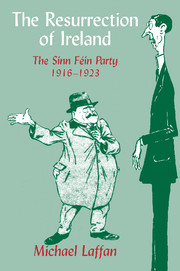Book contents
- Frontmatter
- Contents
- List of illustrations
- List of figures and tables
- Preface
- Note on the text
- List of abbreviations
- PROLOGUE: BEFORE THE EASTER RISING
- THE IRISH REVOLUTION, 1916–1923
- 2 Rebellion and hibernation, 1916
- 3 Organizers and converts, 1917
- 4 Reverses and victory, 1918
- 5 The party: structures and members
- 6 Policy: beliefs and attitudes
- 7 War and repression, 1919–1921
- 8 Ministers and bureaucrats, 1919–1921
- 9 The treaty and the split, 1921–1922
- 10 The Pact election and the Civil War, 1922–1923
- EPILOGUE: AFTER THE CIVIL WAR
- Select bibliography
- Index
9 - The treaty and the split, 1921–1922
Published online by Cambridge University Press: 05 March 2012
- Frontmatter
- Contents
- List of illustrations
- List of figures and tables
- Preface
- Note on the text
- List of abbreviations
- PROLOGUE: BEFORE THE EASTER RISING
- THE IRISH REVOLUTION, 1916–1923
- 2 Rebellion and hibernation, 1916
- 3 Organizers and converts, 1917
- 4 Reverses and victory, 1918
- 5 The party: structures and members
- 6 Policy: beliefs and attitudes
- 7 War and repression, 1919–1921
- 8 Ministers and bureaucrats, 1919–1921
- 9 The treaty and the split, 1921–1922
- 10 The Pact election and the Civil War, 1922–1923
- EPILOGUE: AFTER THE CIVIL WAR
- Select bibliography
- Index
Summary
The Sinn Féin party was not involved in the treaty negotiations. This was a natural and obvious corollary of its relegation by the Dáil and the Irish cabinet; both in practice and in theory it was no more than a political party which offered its support to a government in office – even if that government operated under unusual circumstances and exercised only limited powers. Between October and December 1921 Sinn Féin members waited on the results of the discussions in London with the same hope, impatience and apprehension as did the rest of the country.
Manoeuvres
Almost everyone in Ireland wanted peace, and most nationalists would have been content with a compromise settlement; after all, until only a few years earlier the overwhelming majority of Sinn Féiners had either supported or acquiesced in the home rule policies of John Redmond. Moderates might have felt reassured by Lloyd George's offer of dominion status and by de Valera's declaration in the Dáil that ‘we are not Republican doctrinaires’. On receipt of the British invitation to talks in London de Valera did not reassert his republican beliefs; instead, he invited Irish unionists to meet him, on the grounds that his response to Lloyd George's initiative would affect the minority population on the island no less than the majority. When entering these discussions he described himself not as president but as ‘spokesman for the Irish Nation’; Griffith later drew attention to this point.
- Type
- Chapter
- Information
- The Resurrection of IrelandThe Sinn Féin Party, 1916–1923, pp. 346 - 385Publisher: Cambridge University PressPrint publication year: 1999



